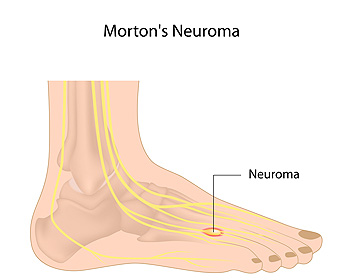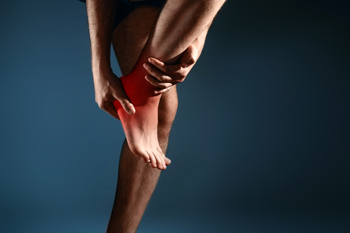 The symptoms of a condition that is referred to as athlete’s foot may consist of dry, flaky and cracked skin between the toes or on the soles of the feet. It is typically caused by a fungus which thrives in warm and moist areas. These may include public swimming pools, shower room floors, or locker rooms. It is known to be extremely contagious, and there are measures that can be implemented to avoid contracting athlete’s foot. These may consist of wearing appropriate shoes in public areas, and keeping your shoes and socks dry. Additionally, it may be helpful to wash and dry your feet daily, followed by utilizing a powder between the toes. This may aid in keeping the feet dry. If you have athlete’s foot, it is advised to consult with a podiatrist who can properly diagnosis and treat this condition.
The symptoms of a condition that is referred to as athlete’s foot may consist of dry, flaky and cracked skin between the toes or on the soles of the feet. It is typically caused by a fungus which thrives in warm and moist areas. These may include public swimming pools, shower room floors, or locker rooms. It is known to be extremely contagious, and there are measures that can be implemented to avoid contracting athlete’s foot. These may consist of wearing appropriate shoes in public areas, and keeping your shoes and socks dry. Additionally, it may be helpful to wash and dry your feet daily, followed by utilizing a powder between the toes. This may aid in keeping the feet dry. If you have athlete’s foot, it is advised to consult with a podiatrist who can properly diagnosis and treat this condition.
Athlete’s foot is an inconvenient condition that can be easily reduced with the proper treatment. If you have any concerns about your feet and ankles, contact one of our podiatrists from San Antonio New Step. Our doctors will treat your foot and ankle needs.
Athlete’s Foot: The Sole Story
Athlete's foot, also known as tinea pedis, can be an extremely contagious foot infection. It is commonly contracted in public changing areas and bathrooms, dormitory style living quarters, around locker rooms and public swimming pools, or anywhere your feet often come into contact with other people.
Solutions to Combat Athlete’s Foot
Athlete’s foot can cause many irritating symptoms such as dry and flaking skin, itching, and redness. Some more severe symptoms can include bleeding and cracked skin, intense itching and burning, and even pain when walking. In the worst cases, Athlete’s foot can cause blistering as well. Speak to your podiatrist for a better understanding of the different causes of Athlete’s foot, as well as help in determining which treatment options are best for you.
If you have any questions please feel free to contact one of our offices located in San Antonio, TX. We offer the newest diagnostic and treatment technologies for all your foot and ankle needs.
Read more about Athlete’s Foot The pain and discomfort that is typically associated with Morton’s neuroma is located on the ball of the foot. Many patients may notice swelling and feel a burning sensation in that area of the foot, and it may affect the way you walk. It generally occurs as a result of a thickened nerve that leads to the toes. This may happen from wearing shoes that are too tight and may cause the affected nerve to become irritated. There may be other causes of Morton’s neuroma, and these may include having flat feet, or medical conditions such as hammer toes or bunions. It is important to have a proper diagnosis performed. This can be accomplished by having an X-ray taken, which may be helpful in eliminating other conditions that may exist. If you feel you have this condition, it is advised to consult with a podiatrist who can suggest wearing insoles or recommend foot strengthening exercises.
The pain and discomfort that is typically associated with Morton’s neuroma is located on the ball of the foot. Many patients may notice swelling and feel a burning sensation in that area of the foot, and it may affect the way you walk. It generally occurs as a result of a thickened nerve that leads to the toes. This may happen from wearing shoes that are too tight and may cause the affected nerve to become irritated. There may be other causes of Morton’s neuroma, and these may include having flat feet, or medical conditions such as hammer toes or bunions. It is important to have a proper diagnosis performed. This can be accomplished by having an X-ray taken, which may be helpful in eliminating other conditions that may exist. If you feel you have this condition, it is advised to consult with a podiatrist who can suggest wearing insoles or recommend foot strengthening exercises.
Morton’s neuroma is a very uncomfortable condition to live with. If you think you have Morton’s neuroma, contact one of our podiatrists of San Antonio New Step. Our doctors will attend to all of your foot and ankle needs and answer any of your related questions.
Morton’s Neuroma
Morton's neuroma is a painful foot condition that commonly affects the areas between the second and third or third and fourth toe, although other areas of the foot are also susceptible. Morton’s neuroma is caused by an inflamed nerve in the foot that is being squeezed and aggravated by surrounding bones.
What Increases the Chances of Having Morton’s Neuroma?
Morton’s neuroma is a very treatable condition. Orthotics and shoe inserts can often be used to alleviate the pain on the forefront of the feet. In more severe cases, corticosteroids can also be prescribed. In order to figure out the best treatment for your neuroma, it’s recommended to seek the care of a podiatrist who can diagnose your condition and provide different treatment options.
If you have any questions, please feel free to contact one of our offices located in San Antonio, TX. We offer the newest diagnostic and treatment technologies for all your foot care needs.
Read more about Morton's Neuroma If you experience pain in your calf muscle, you may have injured your Achilles tendon. It connects the heel bone to the calf muscles, and is known to be the largest tendon in the body. An injury may occur as a result of partaking in specific sporting activities. Additionally, there may be medical conditions that may cause an Achilles tendon injury, which may include gout or other forms of arthritis. There are noticeable symptoms that often accompany this type of injury. Some patients feel pain in the heel area of the foot, and may have difficulty in pointing the toes downward. After a correct diagnosis is performed that confirms a torn Achilles tendon, correct treatment may begin, which may include surgery or non-surgical options. If you feel you may have ruptured your Achilles tendon, it is advised that you speak to a podiatrist who can properly treat this condition.
If you experience pain in your calf muscle, you may have injured your Achilles tendon. It connects the heel bone to the calf muscles, and is known to be the largest tendon in the body. An injury may occur as a result of partaking in specific sporting activities. Additionally, there may be medical conditions that may cause an Achilles tendon injury, which may include gout or other forms of arthritis. There are noticeable symptoms that often accompany this type of injury. Some patients feel pain in the heel area of the foot, and may have difficulty in pointing the toes downward. After a correct diagnosis is performed that confirms a torn Achilles tendon, correct treatment may begin, which may include surgery or non-surgical options. If you feel you may have ruptured your Achilles tendon, it is advised that you speak to a podiatrist who can properly treat this condition.
Achilles tendon injuries need immediate attention to avoid future complications. If you have any concerns, contact one of our podiatrists of San Antonio New Step. Our doctors can provide the care you need to keep you pain-free and on your feet.
What Is the Achilles Tendon?
The Achilles tendon is a tendon that connects the lower leg muscles and calf to the heel of the foot. It is the strongest tendon in the human body and is essential for making movement possible. Because this tendon is such an integral part of the body, any injuries to it can create immense difficulties and should immediately be presented to a doctor.
What Are the Symptoms of an Achilles Tendon Injury?
There are various types of injuries that can affect the Achilles tendon. The two most common injuries are Achilles tendinitis and ruptures of the tendon.
Achilles Tendinitis Symptoms
Rupture Symptoms
Treatment and Prevention
Achilles tendon injuries are diagnosed by a thorough physical evaluation, which can include an MRI. Treatment involves rest, physical therapy, and in some cases, surgery. However, various preventative measures can be taken to avoid these injuries, such as:
If you have any questions please feel free to contact one of our offices located in San Antonio, TX. We offer the newest diagnostic tools and technology to treat your foot and ankle needs.
Read more about Achilles Tendon Injuries Many people have experienced foot pain at some point in their lives. There are many different forms of this type of pain, and it may come from a variety of reasons. If you have heel pain, you may have what is known plantar fasciitis. This happens when the tissue that connects the heel to the toes becomes inflamed, and pain is typically felt in the heel or on the sole of the foot. If there is discomfort and pain under the toes near the ball of the foot, a condition that is referred to as metatarsalgia may be present. This may develop as a result of frequently participating in running and jumping activities, which may put stress on that part of the foot. If you have pain at the bottom of the big toe, you may have a condition that is known as turf toe. This is considered to be a sprain of the big toe. If you are having any type of foot pain, it is suggested to consult with a podiatrist who can properly treat any foot ailments you may have.
Many people have experienced foot pain at some point in their lives. There are many different forms of this type of pain, and it may come from a variety of reasons. If you have heel pain, you may have what is known plantar fasciitis. This happens when the tissue that connects the heel to the toes becomes inflamed, and pain is typically felt in the heel or on the sole of the foot. If there is discomfort and pain under the toes near the ball of the foot, a condition that is referred to as metatarsalgia may be present. This may develop as a result of frequently participating in running and jumping activities, which may put stress on that part of the foot. If you have pain at the bottom of the big toe, you may have a condition that is known as turf toe. This is considered to be a sprain of the big toe. If you are having any type of foot pain, it is suggested to consult with a podiatrist who can properly treat any foot ailments you may have.
Foot Pain
Foot pain can be extremely painful and debilitating. If you have a foot pain, consult with one of our podiatrists from San Antonio New Step. Our doctors will assess your condition and provide you with quality foot and ankle treatment.
Causes
Foot pain is a very broad condition that could be caused by one or more ailments. The most common include:
Diagnosis
To figure out the cause of foot pain, podiatrists utilize several different methods. This can range from simple visual inspections and sensation tests to X-rays and MRI scans. Prior medical history, family medical history, and any recent physical traumatic events will all be taken into consideration for a proper diagnosis.
Treatment
Treatment depends upon the cause of the foot pain. Whether it is resting, staying off the foot, or having surgery; podiatrists have a number of treatment options available for foot pain.
If you have any questions, please feel free to contact one of our offices located in San Antonio, TX. We offer the newest diagnostic and treatment technologies for all your foot care needs.
Read more about Foot Pain